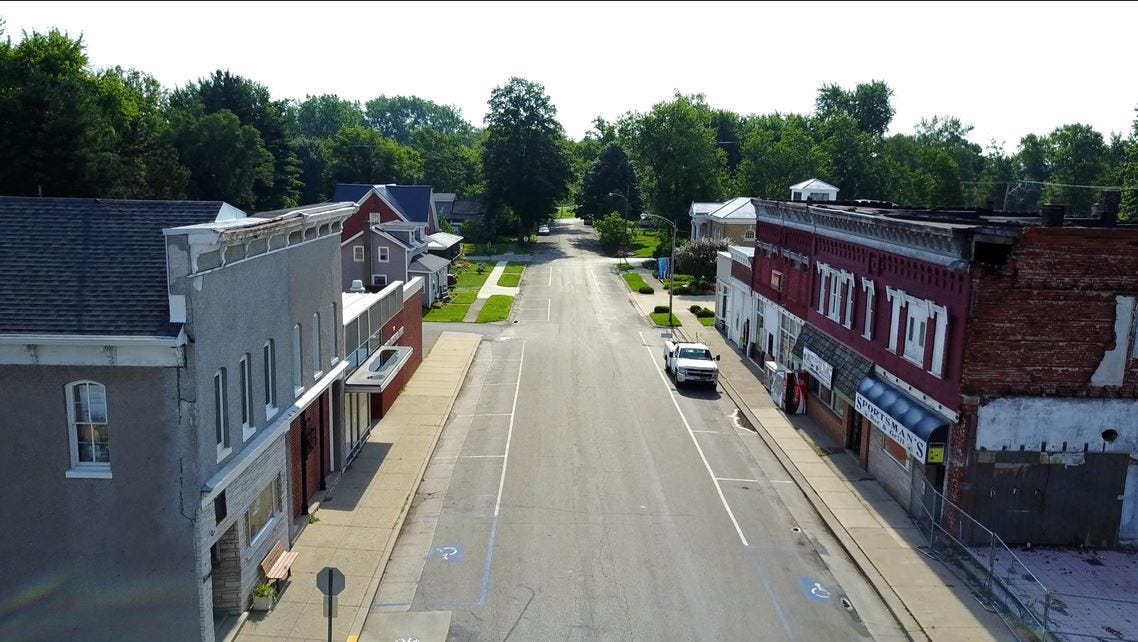Indy Film Fest: Welcome to Monterey
This ageless, gentle documentary looks at life inside a sleepy little Indiana town where most of the businesses are closed up but Hoosier hearts swing wide open.
Click here for Indy Film Fest showtimes and tickets
I admit it doesn't seem like that compelling of a subject for a feature-length documentary. "Welcome to Monterey" is just what the name says: a look at life in a tiny northwest Indiana hamlet of just over 200 souls.
The high school closed up long ago, then the middle school and the elementary school a few years back, and most of the businesses along the town of Monterey's main street are shuttered. The Purina factory is long gone and with it the railroad stop. The one town marshal turned in his badge decades ago, though the all-volunteer fire station is still going.
The town council building also doubles as the sewage treatment plant, but the hardware store is still open and the owner says it will be "until the building falls down." That may sound like an idle boast, except the lone bar a couple doors down did just that.
Most everything may be closed, but these Hoosier hearts swing wide open. If you want a peek at why people stubbornly stay in a town some erroneously call "dying," here is your chance to explore what real Americana looks like, not the neon-lit version you see in themed chain pubs.
Writer/director Lauren Z. Ray (interview here) is a Monterey native who can trace her family's roots there back 150 years, to a time when it was known as Buena Vista. That seems a strange name for a place with such cold winters, but the townsfolk actually had to change it when they found there already was another Indiana city with that moniker. They picked the name of some Mexican general, and Monterey was (re)born.
Not many people come here, but when they do they tend to stay. The library director has been in her job since the 1970s, but she's a piker compared to the bank president, who's held that title since 1953. Three pioneer families form the crux of the local genealogy, and people all know each other or share relations. The houses didn't even have address numbers until fairly recently in history when it became necessary for 911 dispatch reasons.
Shot over a few years, "Welcome to Monterey" uses as its framing device the build-up to the annual Monterey Days, a four-day celebration surrounding Labor Day that includes parades, games, food, a car show, a Miss Monterey contest and a whole lot more. The kids love it because their ghost town is briefly filled with people and frivolity once a year. Though the Lions Club is still a little cheesed off because the festival, a mere 20 years old, tapered off the traffic to their Labor Day breakfast.
It all may sound hokey to big-city types. But you have to live in someplace like Monterey to absorb the homey mood and get in tune with the rhythm of small town life. Just because the music has a slower tempo doesn't mean it's not worth dancing to.
I grew up in the suburbs of a biggish city, and have lived in New York City, Washington D.C. and Chicago, and spent enough time in other metropolitan centers to grasp why people, especially young folks, want to live there. The feeling of being "in it." It's a lure to those who want to dream big.
But I've also lived in a country oasis whose name means "crooked muddy river" in Seminole, where you had to drive 20 minutes to get to a real grocery store and the local post office takes some convincing before they'll let you put up a new mailbox at the end of your dirt road.
In these places people still talk about the time the gas station blew up decades ago, or when the bar literally crumbled into the earth before your eyes. Everyone knows everyone's business, so privacy is not high on the menu. But people have a way of coming together when times are tough -- though they may bolt when you raise the price of beef five cents.
"Welcome to Monterey" is low-budget and it sometimes shows, such as the way a few pieces of video are reused one or more times. But the cinematography is lovely, with some beautiful high-altitude shots and portraits of the people that capture their hearts as straight as an arrow.
What will happen to Monterey? Who really knows. But this moving documentary about an authentic place makes us think that maybe nothing has to.





Well said, as a child of Monterey from 1960 to forever in my heart.